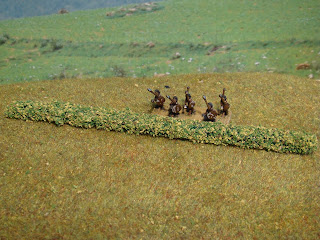These models really were a pleasure to paint, probably the best 10mm models I've come across so far. I'm fairly pleased with the paint job as well, so I've posted the pictures a little bigger than normal (you can click on them to make them even bigger and even zoom in from there should you wish).
They have nice crisp details and only on the legs do you have to force the detail with the paint job, the rest of the model can be just highlighting raised areas.

The bases aren't totally finished, they need edging with yellow, and I'd like to add some dead coloured static grass or little silflor tufts of dead grass just to liven up the bases. I hand painted a different shield design for each unit, one has them painted like rawhide, the other has leather shields with the Carthage stylised figure in white, which seems to appear on a few Carthage shields. I rushed the stylised figures a bit and the finish is a bit shabby, but I'm hopeful of doing better on my upcoming Numidian Horsemen.
The actual leather shields themselves were painted with a basecoat of GW Scorched Brown and then stippled with a stiff brush with a couple of layers of GW Dark Flesh and then a final stippled layer of Vermin Brown. This give the effect of depth and texture on the flat surface.
 A group shot of them ready to harass the enemy flanks!!
A group shot of them ready to harass the enemy flanks!!
Hopefully next time it'll be their partners in crime the Numidian Light Cavalry. I'm putting the finishing touches to 3 units at the moment.
Thanks for looking!













